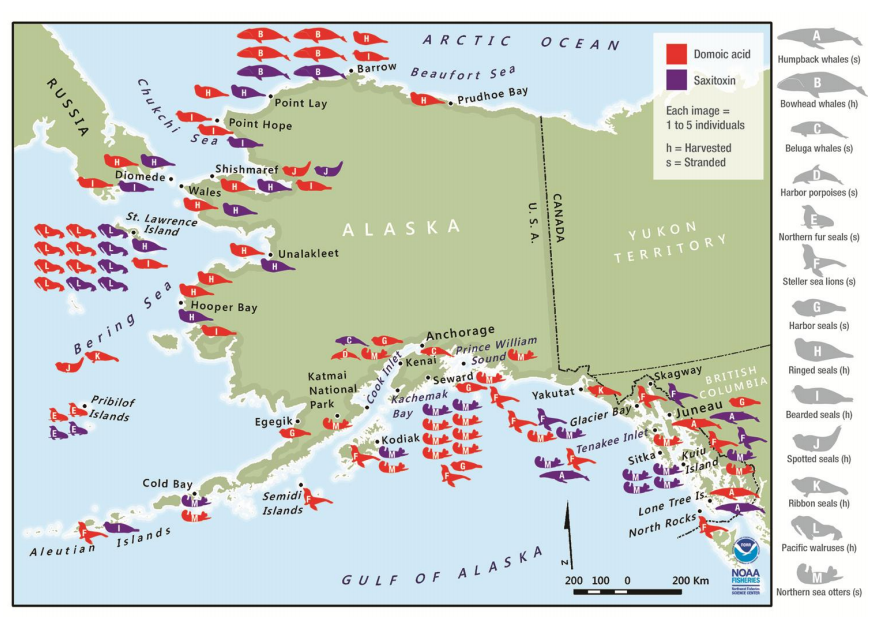This project aims to determine harmful algal bloom species composition and cell densities in Alaskan waters, and to model toxin transfer pathways to zooplankton, shellfish, finfish, and marine mammals, and potential risks to human health.
Why We Care
As the climate has warmed over the past few decades, Arctic and sub-Arctic waters have experienced dramatic changes. These changes have begun to significantly impact the hydrographic structure and stratification of the Alaskan continental shelf, as well as the timing and extent of biological production and the biogeographic boundaries of a wide range of species at all trophic levels. Although many organisms may spread into or expand within Arctic waters as a result of the observed warming trend, few present such threats to human and ecosystem health as harmful algal bloom (HAB) species, particularly the dinoflagellate Alexandrium catenella and diatoms in the genus Pseudo-nitzschia. This threat is evidenced by observations of the neurotoxins saxitoxin and domoic acid in seals, walruses, sea lions, whales, and other marine mammals in Alaskan waters.
What We Are Doing
Our goal is to develop quantitative models for the trophic transfer and impacts of HAB toxins in Arctic and Subarctic food webs using empirical data on the abundance of toxin-producing Pseudo-nitzschia and Alexandrium species, corresponding toxin levels in multiple trophic levels, and health assessments and behavioral observation data for marine mammals and fish.
The scientific objectives of the study are to:
-
- Identify species composition and map cell densities of toxin-producing Pseudo-nitzschia and Alexandrium species (including Alexandrium cysts) via ships of opportunity and local sampling by Alaskan communities in the Beaufort Sea, Chukchi Sea, Bering Strait, NE/SE Bering Sea, and Gulf of Alaska;
- Quantify corresponding toxin concentrations (domoic acid and saxitoxin) in phytoplankton, zooplankton, finfish, shellfish and marine mammals sampled during the same time frame from the same regions;
- Define trophic transfer pathways via stomach content analyses in fish and marine mammals;
- Document health impacts in naturally-exposed marine mammals and fish in relation to toxin concentrations and bloom densities using behavioral observation reports completed by fishers and subsistence hunters as well as full diagnostic necropsies to determine cause of death including detailed pathology examinations by board certified veterinarians in opportunistically-collected fresh stranded animals; and
- Use the environmental and observational data generated from objectives 1–4 to develop toxin trophic transfer models to predict the accumulation, biotransformation, and impacts of algal toxins under different bloom scenarios to predict future animal mortality events.

Locations where algal toxins were detected in samples from stranded (s) and harvested (h) marine mammals. Red images represent species that tested positive for domoic acid and purple images represent species that tested positive for saxitoxin. Many species contained both toxins confirming co-exposure. The 13 species tested are listed on the side of the figure in gray (Source: Lefebvre et al. 2016).
Dr. Kathi Lefebvre of the NOAA Northwest Fisheries Science Center leads this project, along with co-lead Dr. Donald Anderson (WHOI). Other principal investigators include, Chris Whitehead (SEATOR), Dr. Elizabeth Siddon (NOAA AFSC), Steve Kibler (NOAA NCCOS), Dr. Katherine Hubbard (FL FWRI), Dr. Kathy Burek-Huntington (Alaska Veterinary Pathology Services), Dr. Raphaela Stimmelmayr (North Slope Borough), Gay Sheffield (AK Sea Grant), Dr. Susan Knowles (USGS), Dr. Dean Stockwell (University of Alaska Fairbanks).
The project is funded through the NCCOS Ecology and Oceanography of Harmful Algal Bloom (ECOHAB) Program.
